We had the opportunity to test out the Marco Polo Pet Tracking System from Eureka Technology and were extremely impressed! Pet tracking systems are a topic of conversation that comes up fairly often in the cat adventuring community. There are several different brands and types of pet trackers on the market, and people are curious to know which one is the best. They want to have the peace of mind to know that if their cat slips out of their harness while on an adventure, they will be able to locate the cat.
I’ve read a lot about the different tracking systems available and have never been satisfied enough by how they worked to actually purchase one. In my opinion, they either don’t have a large enough range, they don’t work if you have a poor cell phone signal, they don’t take you to your pet’s exact location, or they have expensive monthly fees.
Then I found the Marco Polo Pet Tracking System. It seemed like it checked all the boxes for features I’d want in a cat tracker.
Disclosure: We were given a Marco Polo Pet Tracking System in exchange for our honest review. All thoughts and opinions expressed in this article are our own.
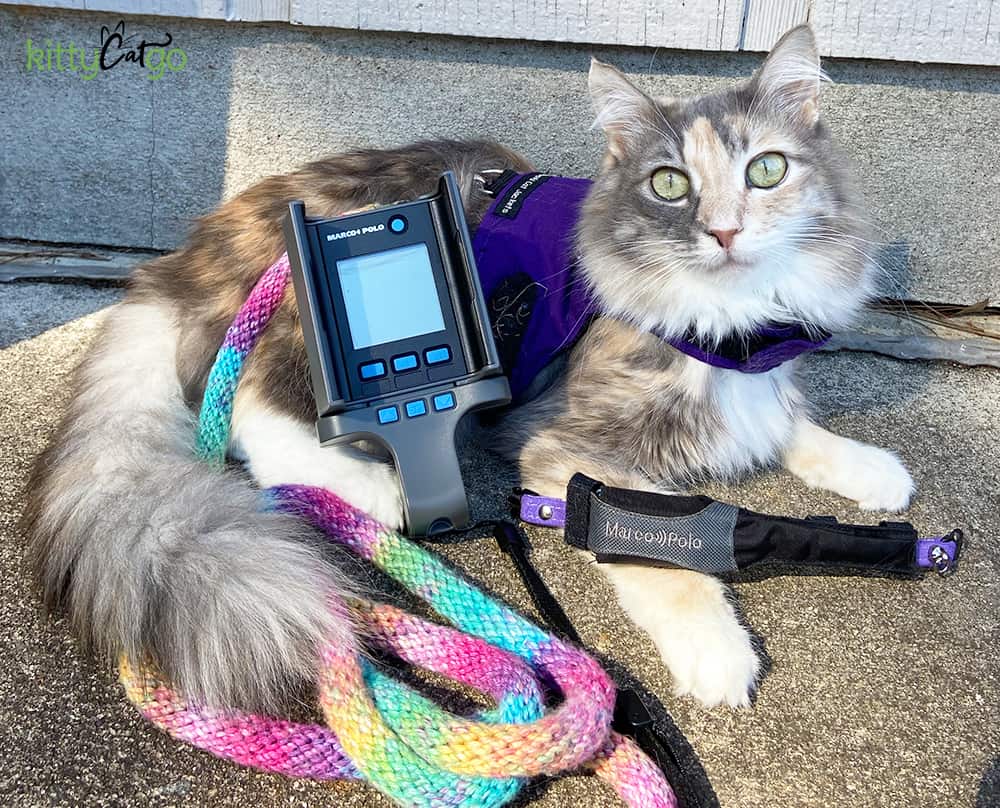
Marco Polo Pet Tracking System Features
- No GPS, cellular service, or internet connection required, so it will work ANYWHERE
- No monthly fees!
- Up to a 2 mile range
- Lightweight tracking tag – weighs 0.8oz (22g)
- Waterproof tracking tag
- Tracks up to 3 pets (you can add a 2nd and 3rd tracking tag at any time!)
- Long battery life – up to 6 weeks
- Extremely easy to use

So… how does the system work?
The Marco Polo Tracking System is an RF tracker, meaning it uses radio frequency to send and receive messages between the handset and the tag. The strength of the transmission received from the tag by the handset is used to indicate distance and direction.
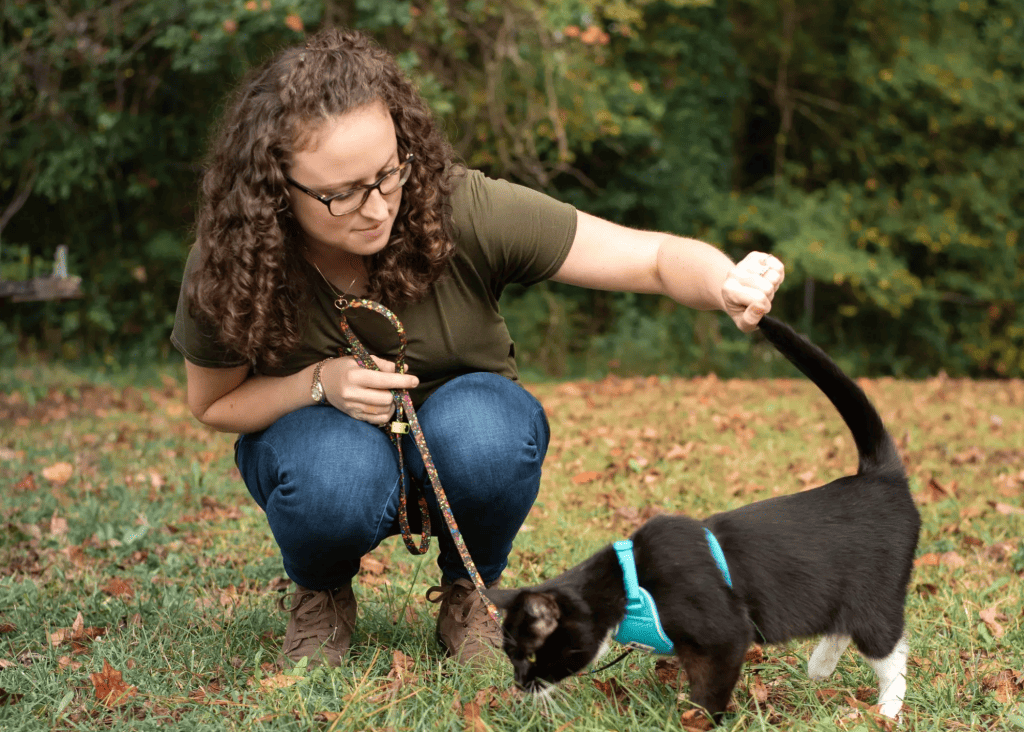
Is your cat meant for a life of adventure?
Take the interactive cat personality quiz to find out!
When in Track mode, the handheld Marco Polo locator sends a signal to the tag on your cat’s collar every 5 seconds. Each time your cat’s tag “hears” the signal from the locator, it responds with a return signal. The locator then measures the strength of the signal coming back from the cat and finds the direction it came from. Both pieces of information are then displayed on the locator’s screen. You simply follow the arrow pointing to your cat and watch as the signal strength gets higher the closer you get. It will bring you within inches of your cat!
Learn more on the Marco Polo FAQ Page!
Tell me more about that 2 mile range!
Marco Polo works up to 2 miles (3.2 km) in line-of-sight situations. Expect about a 1/2 mile to 1 mile (.8 to 1.6 km) range in mildly rolling terrain with moderate vegetation. It really depends on the specific conditions in the area of use, such as terrain, vegetation, and obstructions. If your cat is not within the system’s initial range, you can walk or drive around the areal until you come within range.
Monitor Mode vs Track Mode
The Marco Polo system has two different modes – Monitor and Track. When you’re not actively tracking your cat, you’d keep the system in Monitor Mode. In this mode, the locator “pings” the tag on your cat’s tag once every 40 seconds. It will warn you if your cat is outside of its programed “safe zone” so you can enter track mode and find them.
This is a great feature if you let your cat out in your backyard, for example. You can program your yard as a “safe zone,” and the system will alert you if your cat wanders out of that safe zone. In monitor mode, the locator will also warn you if the battery is low on your cat’s tag.
If your cat goes missing, you enter Track Mode with just one click on the locator!
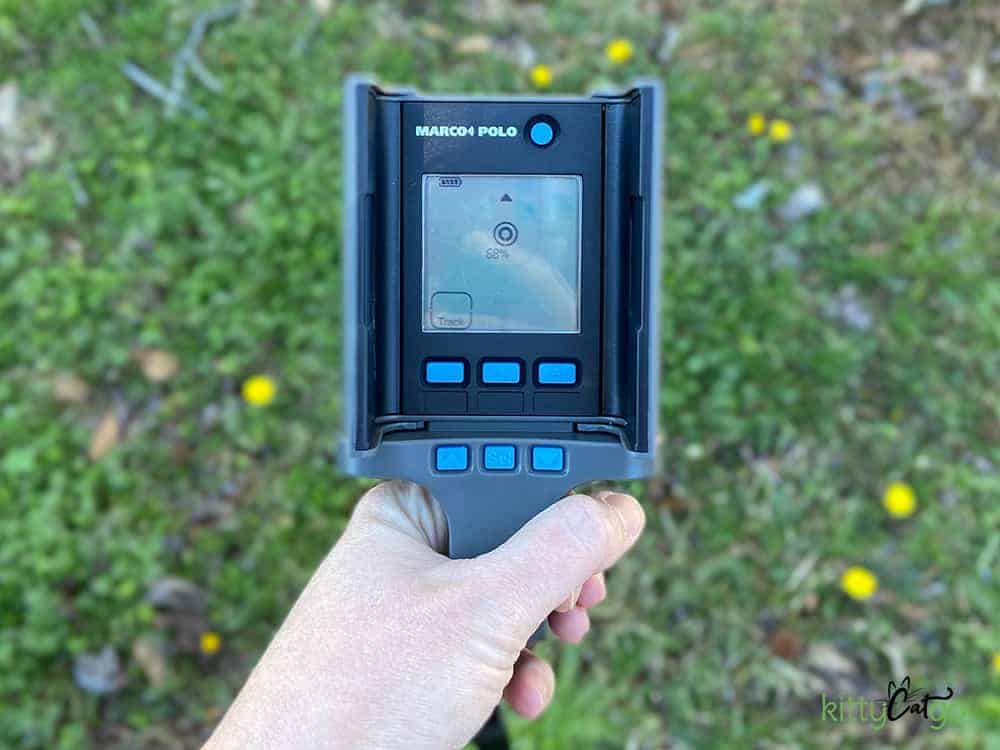
Recommendations from the Company
In Regards to Battery Life…
The President of Eureka Technology Partners, Tim Crabtree, recommends keeping the locator and tag on at all times in monitor mode, leaving the locator plugged in on your kitchen counter or other convenient location.
He says if you run things this way, “you don’t need to ever touch anything, even if the collar or harness with the tracking tag is off the cat, just leave it turned on. About once a month the low battery alarm will go off on the locator letting you know it is time to recharge the collar tag. Charge it up, and you are good for the next month. This way, there is no possibility that you will forget to turn the tag on or leave the house with a battery that is below 25% charge level.”
In Regards to Cats in Trees…
Tim also shared some helpful information with me about using the locator if your cat has climbed a tree —
“You can use the characteristics of the locator to your advantage. Say you are searching for your cat and you get to a spot where you are getting a high signal level but no arrows, or inconstant arrows. If you are under a tree canopy it is possible that the cat is above you, and the locator can only show bearings in the plane of the display. NOW, you can tilt the locator up so you are looking directly into the display like you were looking into a hand mirror. The display will now show the elevation off the ground instead of an azimuth about the horizon. If you then face one direction, say north, move side to side (east and west) until the arrow points straight up, then turn 90 degrees to face east or west and then shuffle sideways again (north and south) until the arrow again points straight up, now you are standing directly under the cat!”
Our Review of the Marco Pet Tracking System
We’ve had the system for a couple months now and have had the opportunity to take it out for a few tests. Before taking it out, I read through the manual, which was very helpful and descriptive. I was able to quickly and easily set the system up, pairing my locator with the cat tracking tag. It took just a few seconds.
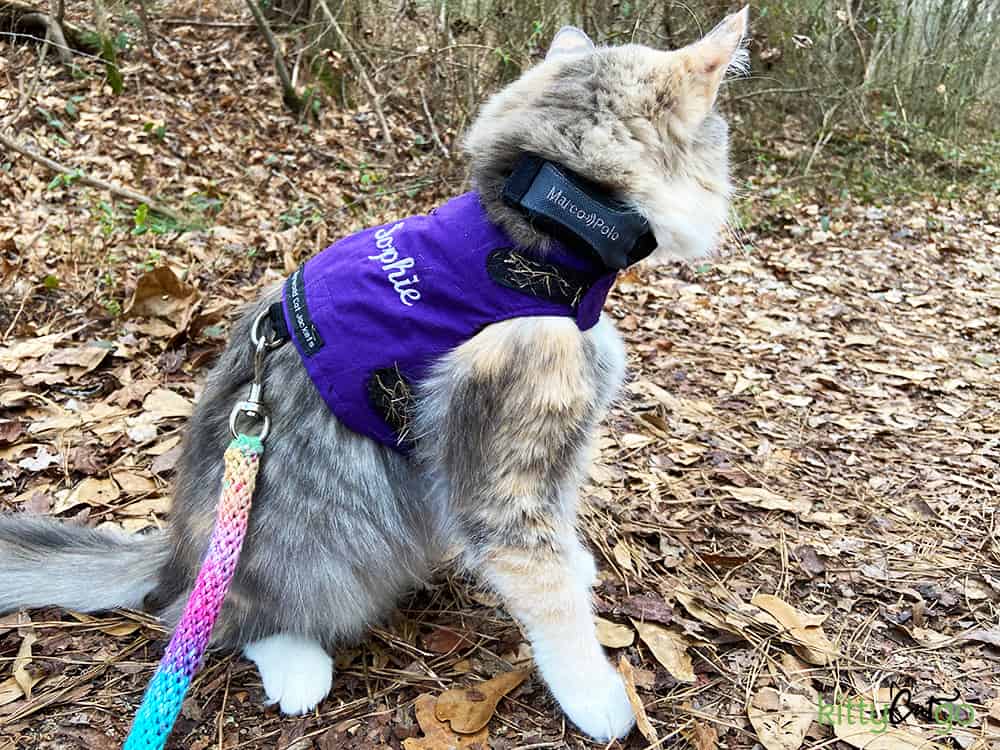
Test #1
My husband and I took our cat Sophie to one of our favorite wooded hiking spots, and we played the most fun game of “Hide and Seek” I’ve ever played. Sophie had the tracking tag on her collar, and she and my husband wandered off into the woods. After giving them about an 8-minute head start, I turned the locator into Track Mode and began my search.
The locator worked just as described in the manual. The display showed me a percentage (indicating how close I was to Sophie) and an arrow pointing me in the direction I needed to go. After about a 6 minute search, following the locator’s directions, it took me right to Sophie and my husband. They were approximately .3 miles from where I started.
*In the video, I was angling the locator towards my camera so you would be able to better see the screen. For better tracking results, the locator should be kept parallel to the ground – like a compass!
Test #2
To test how the system did with some obstruction, my husband took the tracking tag on Sophie’s collar and hid it inside a log about .25 miles from where I started. I again used the locator to find the tag. As I got closer to the tag’s location, the locator did get a little bit confused about which direction I should go. It did ultimately take me right to the tag though.
Other Things to Note:
Though the tracking tag is lightweight (0.8oz / 22g), it does take up more collar space than other tracking tags. It requires a minimum collar length of about 7 inches. I tried it on all three of my adventuring kitties, and none of them minded it though. They didn’t even seem to notice it was there.
Also, the Velcro tabs that attach the tag to the collar are very long. This is so it can fit on thicker dog collars. I just cut the tabs so the tracker would fit more snuggly on my cats’ collars.
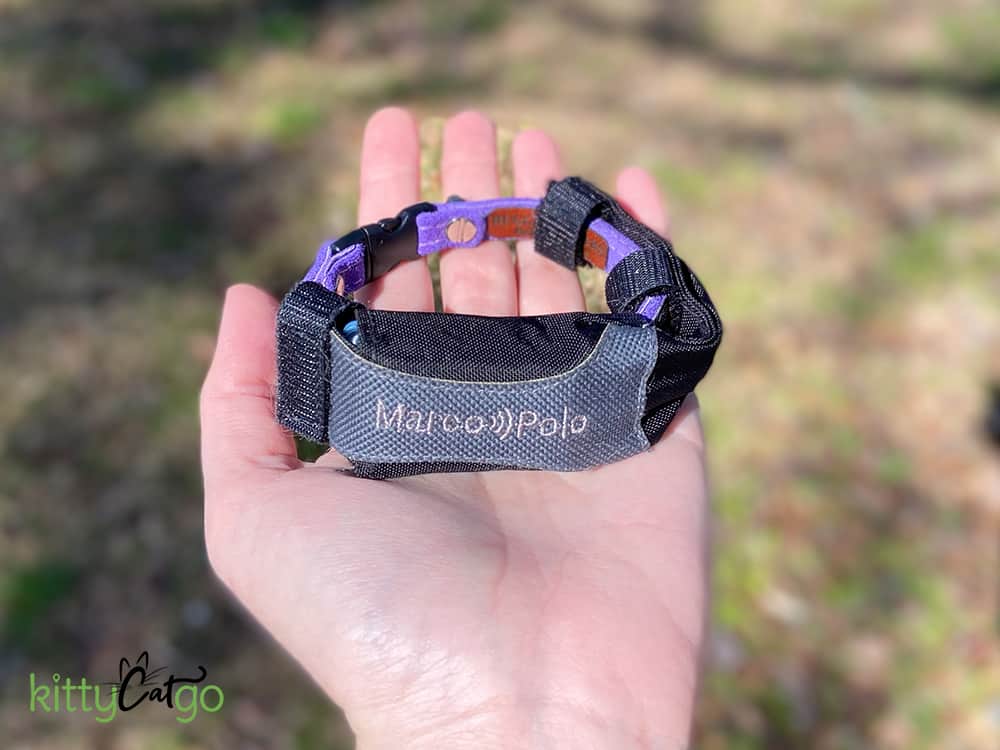
My Final Thoughts on the Marco Polo Pet Tracking System
I love it and would definitely recommend to anyone. It was extremely easy to use and has all the features and functionality I would want in a cat tracking system. Yes, it is on the more expensive side, but in the long-run it ends up being less expensive than the systems that have monthly fees.
It also seems to work better and more accurately than its competitors. If my cat gets lost on an adventure, I want to know that I’ll be taken right to them. Marco Polo does that.
>> Shop the Marco Polo Tracker <<

Is your cat meant for a life of adventure?
Take the interactive cat personality quiz to find out!
About the Author
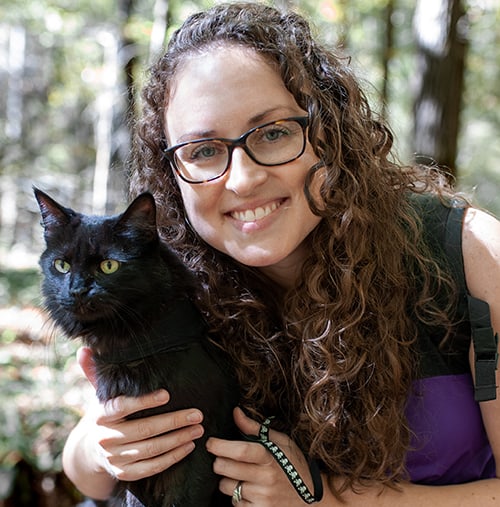
Emily Hall, ABCCT is a certified cat trainer and cat adventure enthusiast. As a “mom” to six cats and one dog, she has been writing in the pet industry for 10 years, with a focus on traveling and adventuring with cats. Emily has a passion for getting out there and doing more with her cats – for pushing the bounds of cat expectations! She and her husband enjoy hiking, road-tripping, camping, and canoeing with their three cat adventurers. Read more about Emily here.

WOW!! This looks a lot better than most of the other trackers on the market. It fits cats (most fit dogs and weight too much and cost too much). It looks solid and reliable and I am impressed with your video demonstration.
It’s been several years since you wrote this. Do you still recommend it? My cat was missing for five (!!) years. He’s home now. At the moment, he’s happy inside, but I know that won’t last forever. This adventure used up most of our nine lives, and neither of us wants anymore.
This review was written two months ago. I definitely still recommend the Marco Polo!
Emily, the link to buy from Amazon says it’s unavailable to purchase, do you know why it’s not available through Amazon to purchase? It seems a bit unfair that you don’t get commission for a sale not that I can find a place that’s selling it. It’s only available in the USA but I’m in the UK
My guess is the seller hasn’t restocked their Amazon supply. Sorry about that! Have you tried going directly through their site? https://eurekaproducts.com/ I’m not sure if they ship to the UK or not though
Thank you Emily
I wish I had known about this product, My 1 yr old AliCat went out for fresh air and we have not seen her since the 25th of May… She is Microchipped yet unfortunately not able to locate her like this MarcoPolo product would have been able to assist…
I’m so sorry to hear your kitty went missing! I’d recommend visiting https://www.lostcatfinder.com/ – Kim has some great resources and services to help find lost cats!
Same. I’m here researching cat tracking devices because I’ve got a missing cat 🙁
This sounds really interesting. I have been debating working Lucifer up to the point of being able to go off-leash hiking where it’s permitted. His recall is coming along SO well, but I think having something like this would ease my mind even more about taking that big step.
It is a great tool for that for sure!
We have been using our Marco Polo tracker for over 2 years now, and just added a second unit when we expanded to four cats. We walk our cats daily in rural private property and let them come and go from our converted school bus home during the daylight. And because we have a mobile lifestyle, we cannot count on having a cell signal in some places, so having a self-contained system that relies on its own radio signal is crucial.
We could barely afford the first one at the time but have been so grateful to have made that investment in our peace of mind and our cats’ safety. The doors on the older handheld unit are a little floppy and loose now, but it tracks like a champ, still.
We’ve also done the technique described for finding a cat in a tree, except it was just the collar 25 feet up, which our cat had slipped out of. Oh, and say goodbye to lost collars, now. When your cat comes home naked, you can track it down!
So glad to hear that you’ve had such a great experience with the Marco Polo! We love ours too. Thanks for sharing!
Thank you for this. We operate a holistic pet rescue/sanctuary which doesn’t have a firm location. We have an RV and spend most of our time in neighborhoods near family and friends. I wish you could include a test in a dense neighborhood so us mostly-suburban “adventurers” could know if this is the tool for us to keep track of our cats.
Also, have you given any consideration to the potential harm from an RF-emitting device being right against your cat’s neck? My concern would be damage to cells, in particular the thyroid. Thyroids often become cancerous in cats. I would not want to add any stress that contributes to this. If you have looked into it, please share your thoughts.
It would be nice to get a comparison of the RF/EMF output of the various trackers you have trialed.
With Apurrreciation,
Nikki & The Luckitties
Hi Nikki! Thanks for your comment. I don’t know anything about potential harm from RF-emitting devices, I’m sorry. I just did a very quick Google search and skim though, and it doesn’t seem like it’s a concern.
I haven’t tried out any other RF trackers, so I can’t offer a comparison. The only other tracker I’ve tested out so far is the Apple AirTag, which uses BlueTooth.
What brand halter and leash is Sophie wearing in the video?
She’s wearing a Mynwood Cat Jacket harness, and the leash is one I made.
I the AirTag do you actually have to have an Apple IPhone? what about people who have Android (other than IPhone) what can be used?
AirTags only work with other Apple products, like iPhones or iPads. There are other bluetooth tracking devices out there that work with Androids, like a Tile tracker, the Tabcat tracker, etc. Tractive is a GPS tracker that I am in the midst of testing out right now too.
nice article, glad i read it before i purchased the AirTag
Emily how does it perform in an urban environment, i.e. lots of obstruction, do you know?
I haven’t tested it in a more urban setting – I’m sorry. My intentions were to test it out for those who go on adventures with their cats, and those tend to take place in the woods and not in urban environments. It’s something I need to add into my review though.
I will say, the company is very responsive to questions. When I was doing the review, the owner of the company was very quick to respond to emails and was super helpful. It would be worth reaching out through their website and asking about the urban environments.
I would like to know this too. Did you ever find out more about working in an urban environment?
Thanks
I have not
Hi Emily. I bought a Tractive for my first Bengal and even being the small one is big for a cat. Do you know if this one is smaller than the cat Tractive xs. I want to get my little boy a tracker and I live on 17 acres so if he ran off I think an air tag wouldn’t work having farms all around me. I’m going away in a couple of months and want to leave one on him while I’m away incase my son accidentally let him out so he can find him but the Tractive is too big.
According to the Tractive website, the measurements for the Tractive Cat Mini are 2.2 x 1.1 x 0.7 inches / Weight: 0.88 ounces. The Marco Polo is listed as being 6 x 0.63 x 1 inches / Weight: 1.12 ounces. The reason the Marco Polo is so much longer is because it has that wire that comes out of the device, and that is included in the length.
thanks so much for the detailed review, this seems like the best things for me and my cats too. they’re indoor cats who I take out on a leash, only outside supervised, but out hiking and I want the extra peace of mind in case something unforseen ever happens. my big question though is that if I have a tracking collar, and in an emergency my cat gets their leash tangled / backs out of their harness, wouldn’t the tracking collar come off too? the most likely reason I’d need to track my cat would be if they slipped their harness, but then they probably wouldn’t have the tracker on anymore, either? do you have any experience with this?
Whether or not your cat’s tracker comes off if they slip out of their harness depends on so many factors, so I can’t give you a definitive answer. It depends on whether or not you have the tracker attached to a collar or harness, what kind of collar you’re using (breakaway or not) and how tightly you have it adjusted, what kind of harness you’re using and how you have it adjusted, how big the tracking device is and whether or not your cat’s harness would snag it, etc. My best advice is to put your cat’s gear on inside and purposefully try pulling their harness off in order to see if their tracker and collar come off as well – basically see if you can create a situation in which this would happen, and how difficult it is to make it happen.
I personally have never had my cat’s collar and tracker come off if they slip their harness.